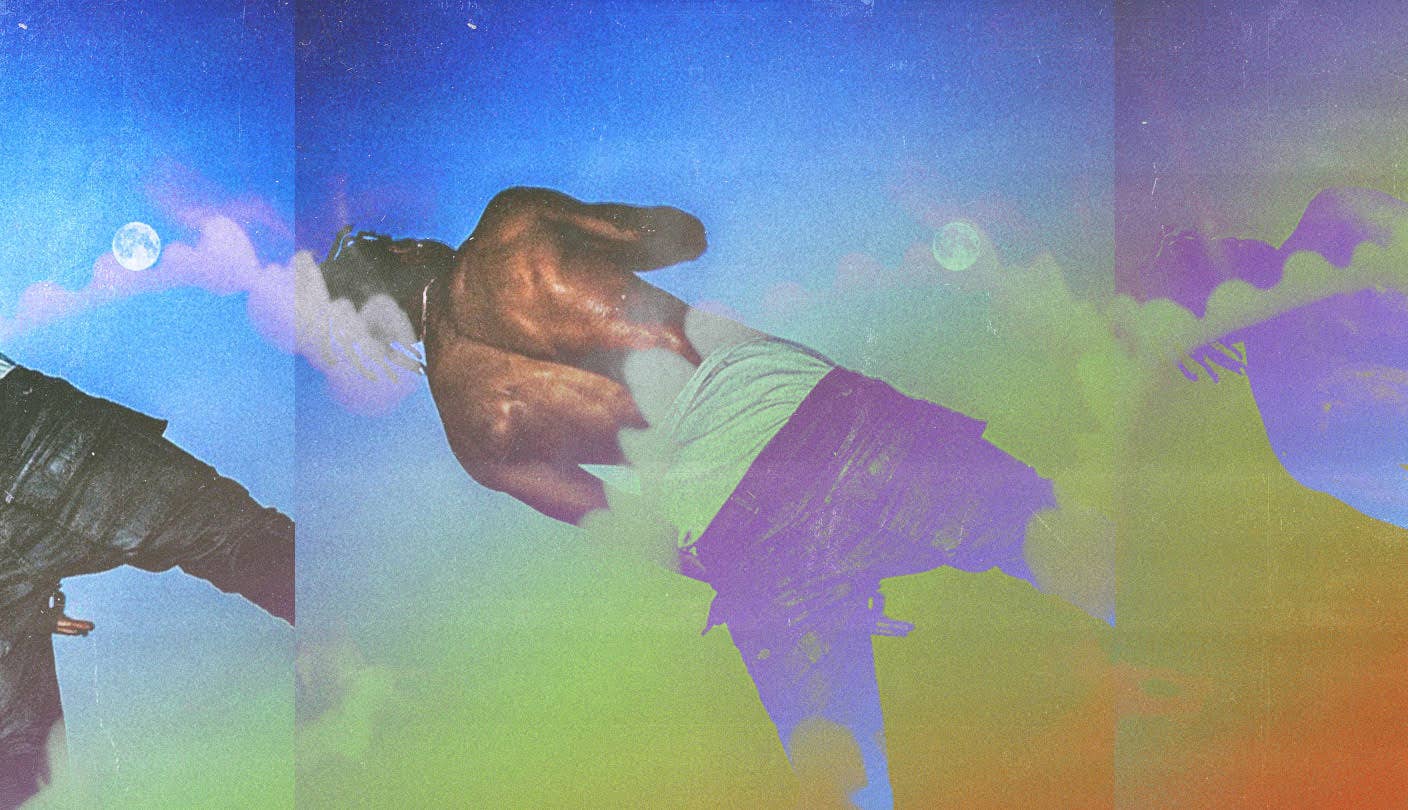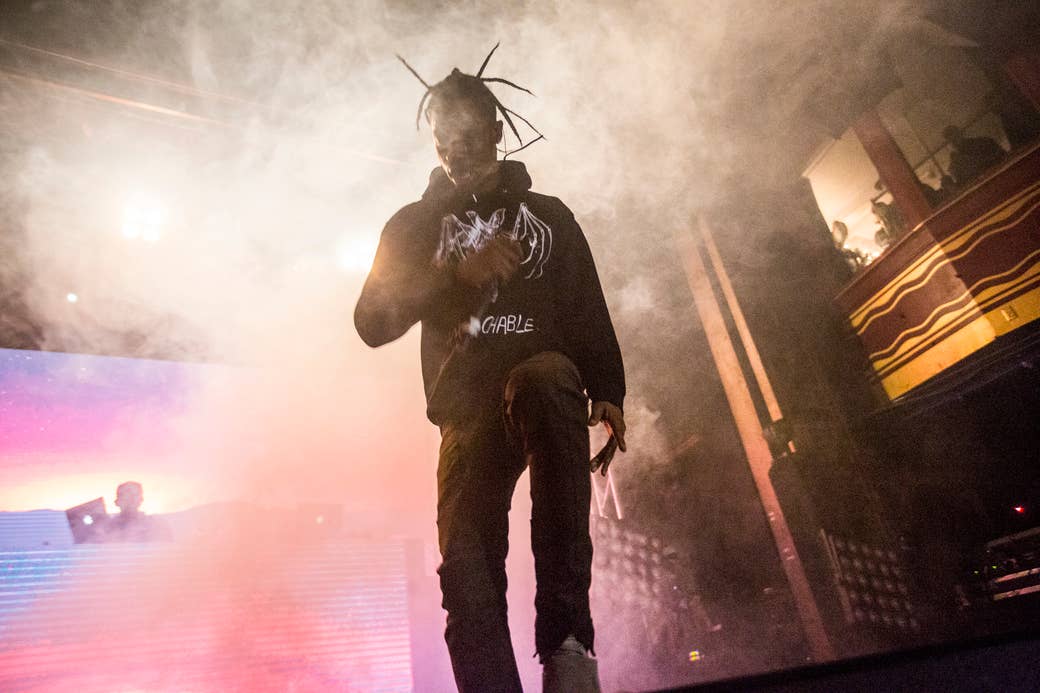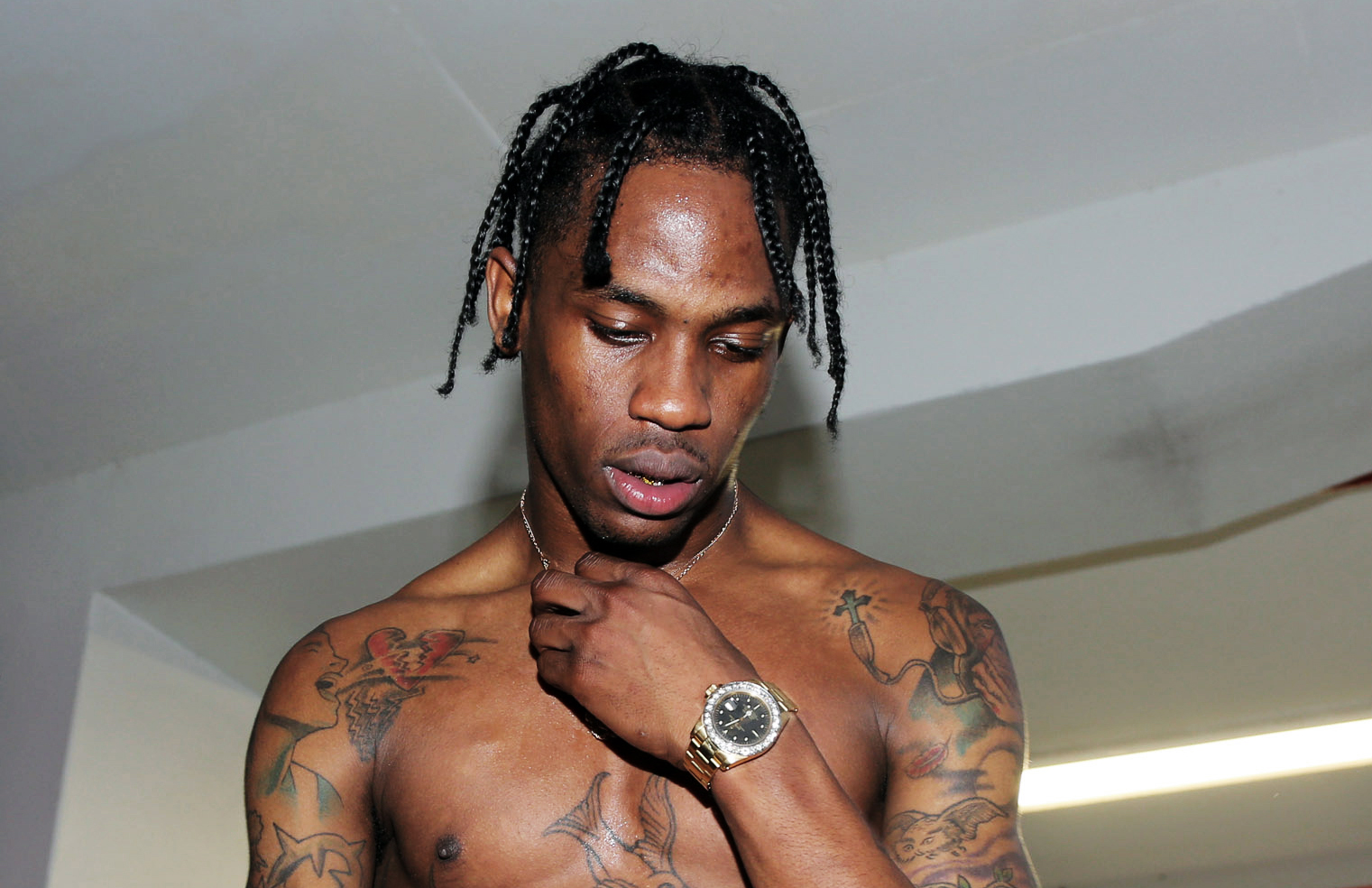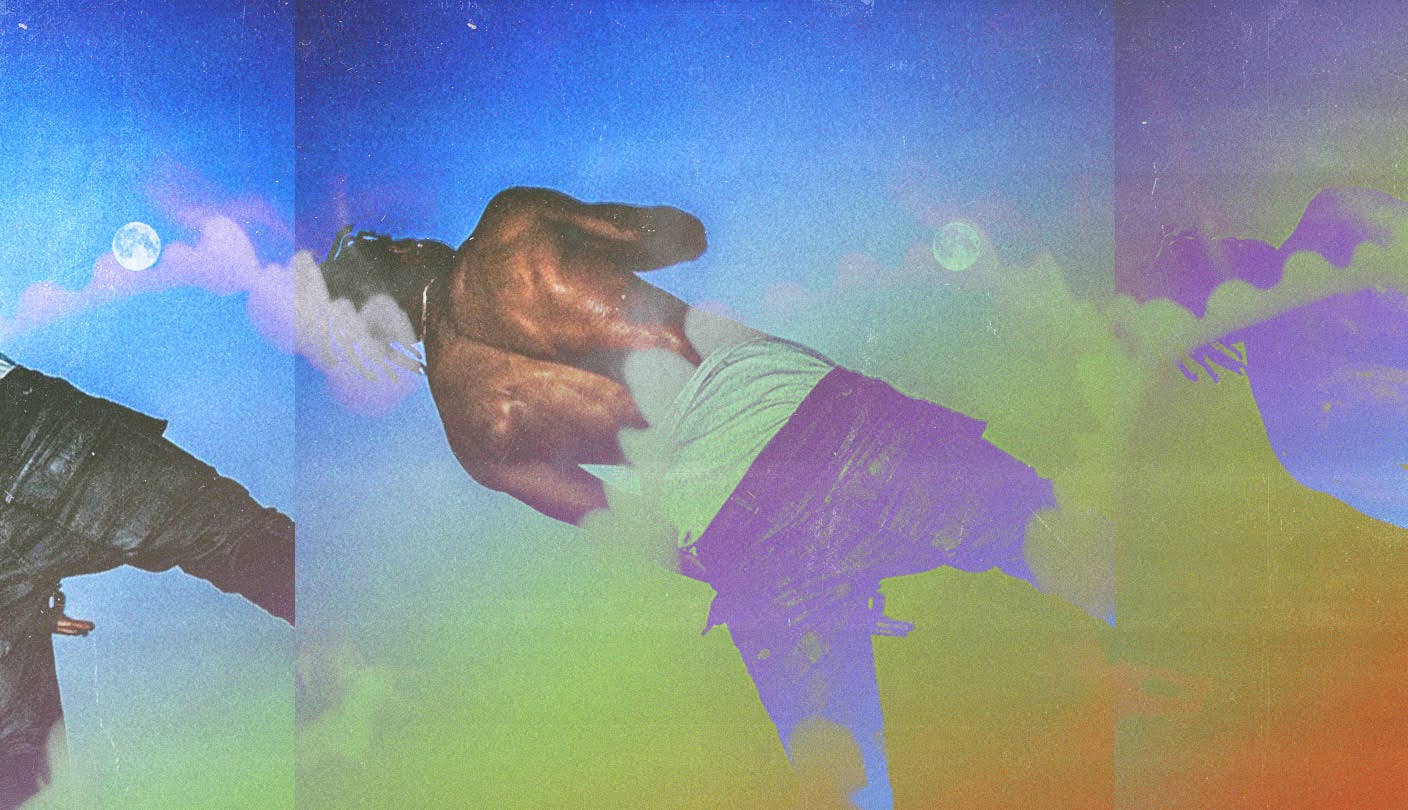
Days Before Rodeo opens with a dark prayer. Over ominous organs and keys, Travis Scott saunters into the frame and details his restlessness: “After three No. 1 albums, woulda thought I’d feel amazing, still impatient.”
The albums he references were among the biggest of 2013: JAY-Z’s Magna Carta Holy Grail, Wale’s The Gifted, and Kanye West’s Yeezus, the latter of which represented a sonic shift that Travis has been credited with at least partly inspiring. Not a bad collaborative resumé for a Houston native whose breakthrough moment had come just a year prior, on West’s G.O.O.D. Music compilation, Cruel Summer.
Fast-forward a year, though, and assisting legends while producing for a new class of stars like Wale and Big Sean wasn’t satisfying enough. Or, to let Travis himself tell it: “I might fuck ’round, lose my mind. I gotta break out.”
Much has been made of the career crossroads at which Travis Scott found himself in the waning days of summer 2018, before the release of ASTROWORLD. His third studio album presented the opportunity to either vault him into the A-list stratosphere or leave him stranded in the upper-middle class of rap. We all know how that worked out: There are showstopping Grammy performances, Super Bowl halftime appearances, and a current status as rap’s No. 1 most sought-after feature as reminders. August 2018 solidified Travis as a superstar.
Five years ago in August 2014, Travis Scott was presented with a similarly high-stakes, career-defining moment—one that, had he not conquered it, might have stalled him out as a compelling G.O.O.D. Music affiliate, and nothing more. Instead, he delivered a project that many fans still use as the gold standard to compare the rest of his albums to: Days Before Rodeo.

“I’m on a mission,” FKI 1st recalls Travis expressing to him. “Are you going to help me or not?”
1st has production credits on nearly every Travis Scott project to date, and the sessions for Days Before Rodeo marked the beginning of their fruitful relationship. Thinking back on those days now, the Atlanta producer recalls how intensely Travis was locked into his work. “I just remember bro being focused,” he says. “No bullshit. Fuck these hoes. Fuck all the partying. There’s never been a time we’ve ever bullshitted in the studio. Everything is always serious.” He clarifies: “Of course [we have fun]. But it’s just like, we’re about to do this for real. No games.”
Travis was introduced to 1st by his Grand Hustle label boss, T.I., who, even by that early point, had resolved to provide Travis with any logistical help he could, and otherwise stay out of his way. “All we could do is offer relationships and resources,” T.I. recounts. “Walk him in doors, introduce him to people, create opportunities. If he called, he usually called to say what he [needed] from me. It ain’t a whole lot of orchestrating or curating that you could really do around Trav. All we did was try to place the settings for him, and the magic happened.”
By 2014, Travis had already built a small but rabid fanbase off the strength of his Cruel Summer placements and a strong debut project of his own, Owl Pharaoh, which yielded a handful of true-blue bangers (“Upper Echelon,” “Uptown,” “Bandz,” “Quintana”) and proved that he did indeed have a singular aesthetic, plus room to grow. With an impressive resume, clear-cut vision, and a live show that was already gaining a reputation for unbridled energy, Travis Scott was brimming with creativity and ambition that outpaced his status in rap’s power rankings. Kinetic energy with no release. Still impatient.
“It was all revolving around the kids. All of his ideas were derived from what the kids wanted to do.” - T.I.
“I think the most important and most crucial advice [I gave him] was to be patient and notice all the advancement, not just major advancement,” T.I. recounts. “At the time, at least to Travis, I remember he felt like he wasn’t getting his just due, and that people weren’t acknowledging him or considering him among the elites in the industry at the time. He felt—and rightfully so, for the most part—that he had more than enough justification to be headlining these shows, having these types of stage setups, and having these accommodations made for him at a time when they were being made for other people.”
Days Before Rodeo, the follow-up to Owl Pharaoh, was left with the task of not only capitalizing on Travis’ potential and hype, but also standing as an undeniable body of work that would firmly push him higher up rap’s, well, echelon. “[Travis] deserves to be sitting in the seat that he’s sitting in now. We thought that then,” T.I. adds. “It was just, shit, getting everyone else to see it our way. That’s what took the time.”
“He knew it was all on his shoulders at that point,” says Alex Tumay, the prolific engineer who mixed half of DBR (Travis handled the other half). “I mean, he fucking was the one in control. He was the one doing all the crazy direction. He had all these images on his computer of what he wanted the album to feel like and he would cycle through them. He had a real strong vision for the project and a real strong idea for where it was going to take him.”
Days season officially began in spring 2014, in May, when “Don’t Play” spread on blogs and music sites. Over a titanic, urgent beat from Vinylz, Travis set the tone for his forthcoming project with a declaration and a promise: “I ain’t playin’ with these niggas!” Rapping double time and delivering a verse that more than manages to stack up against a formidable guest feature from a peak-form Big Sean, Travis backs up that claim. The technical showing, coupled with aesthetic flairs like refashioning a vocal sample from British rock band The 1975’s “M.O.N.E.Y.” into a chant for the intro of the song, riled up both his fanbase and curious onlookers. Now, all he had to do was deliver the rest.

Before Days Before Rodeo impacted on August 18, 2014 at 7:13 p.m. CT, there was a wild dash to finish the project in time.
“Trav pulled up to the studio [the weekend before the release],” Tumay recalls, “and he was like, ‘Bro, we got to do this guerilla-style. We got to knock this shit out in, like, two days.’” As Tumay tells it now, “We turned in the last song, ‘The Prayer,’ about a minute before it actually dropped.”
It’s still unclear exactly why there was such a time crunch for a project being released to the internet for free, but nevertheless, Travis approached it with the seriousness of a debut album. “It was super intense, because he cares so much about the product, and he is so particular about every little sound,” Tumay remembers. “I would say that is a huge part of his success: He just cares more than everybody else about how everything is and how everything is supposed to be. He has this concrete vision locked in from the beginning.” Indeed, in a popular behind-the-scenes video filmed on behalf of Metro Boomin that shows him and Travis creating what would become “Skyfall,” you can see Scott obsessively hovering over Tumay at a computer, dictating notes and ideas.
Clocking in at 12 songs, DBR was immediately met with critical acclaim. The project represents a refinement and polishing of the Western-tinged, Houston-indebted sound he had been cultivating for years: an intriguing mash-up of the gothic and the futuristic, preaching to a dystopia of rowdy kids and ragers in need of an outlet. Throughout the tracklist, Travis flexes his improving ear for song construction. Small touches like the 1975 sample or the way Southside’s thunderous beat for “Quintana Pt. 2” mutates into a breakdown where T.I. materializes out of thin air lend credence to the idea of Travis having a Kanye-level talent for orchestration, particularly in his manner of sourcing the unexpected and directing a song down surprising paths.
Days Before Rodeo is light on guests, but two of the biggest feature moments are akin to stunt-casting. With verses from Young Thug and Rich Homie Quan, who also handles hook duty, “Mamacita” functions as both a Travis and Rich Gang song (one of the buzziest duos of that year). Later on the project, “Sloppy Toppy” amounts to an Avengers-style Atlanta (where Travis recorded much of the project) crossover event, with verses from all three Migos—their first time working with Travis, a partnership that would yield a handful of acclaimed collaborations and a full joint project between him and Quavo—and Peewee Longway.
“It was just me and Travis when we first created the whole song, just his verse and the sample and everything,” says 1st of the “Sloppy Toppy” session. “I just had the main foundation of the beat and he was like, ‘Let’s add some samples to it. Let’s screw it up. Let’s put, like, four or five other people on the song.’ I’m like, ‘Oh, shit, this sounds like a fucking Broadway show or a fucking movie.’ I didn’t even fully see it yet.”
UponDBR’s release, though, suddenly Travis’ vision made a lot more sense to those around him. “I didn't even hear the final thing until it came out and I was like, ‘Oh, shit!’” 1st remembers. “That was the first time [I] worked with the Migos and Peewee Longway; the first time Travis worked with them; and the first time the Migos and Peewee did a collab. So it was all firsts. That’s what was amazing about it. And everybody fucking snapped. It was like every artist on the song inspired the next person to go harder.” (Though, if pressed to pick a favorite, 1st votes Peewee, with Offset as runner-up, because “People in Atlanta will tell you: Peewee Longway is the hardest rapper in Atlanta, low key.”) Ironically, the beat almost never made it to Travis’ hands. “The version without the sample, I actually sent to Post [Malone] a long time ago,” 1st says, laughing. “He always brings that up: ‘Yo, you know I’m the first person you sent ‘Sloppy Toppy’ to, right?’ I completely forgot.”
“All the kids rage to it. Raging became a big thing from that project.” - FKI 1st
FKI 1st is also responsible for “Drugs You Can Try It,” a moody, downtempo (at least by Travis standards) song that many La Flame fans still consider to be a top-five entry in his ever-expanding catalog. “There’s nothing that sounds like it, bro,” 1st muses. “The way the song starts, the melody of the guitar, the way the drums come in, the pauses, the effects on his voice, it’s everything about it that’s just never [been] heard before.” Beyond the sonics, 1st reckons the song’s themes resonate deeply, as well. After all, for the type of kid stanning Travis Scott, the rage is always followed by a come-down. “The first line of the song, ‘I’ll try it if it feels right,’ doesn’t have to be about drugs. It could be about love. It could be about anything, and everybody [can relate] to that position.”
While the main subtext of Days revolves around Travis psyching himself up for a takeover, one of the project’s other primary themes is anchored by a broader changing of the guard. On “Skyfall” Travis bemoans that “your shit ain’t getting me high no more.” One track later, on “Zombies,” he urges “the kids” to sing (“We don’t want their bullshit no more”) in what sounds like the twisted funhouse version of West egging kids on in “We Don’t Care.”
“It was all revolving around the kids,” T.I. explains. “He always would describe the game using the kids, like, ‘because the kids need to,’ and ‘the kids want to.’ All of his ideas were derived from what the kids wanted to do, and what the people who drove miles and miles to see him perform wanted, what he felt they deserved, and what he felt they expected. I felt like that was a visionary’s perspective.”
“Organized chaos” is how Tumay describes Days Before Rodeo. With "Mamacita" finding modest success as a single and The Rodeo, a joint tour with Young Thug, set for 2015, the project very quickly accomplished what Travis intended. The Rodeo is where he cemented his reputation as one of the best live performers—if not the best—in the game. Meanwhile, as more people flocked to DBR, it ended up critically outpacing the debut album it was supposed to serve an appetizer for. Still, regardless of where you might rank each project, Days established expectations for what a Travis Scott project could and should be.
Five years later, Travis is still perceived as a quote-unquote “album artist,” because, as Tumay puts it, “He has the concept that he doesn’t put it out until it is where he wants the album to be,” a process that keeps his fans assuaged when they grow restless during the stretches between his album cycles (which can be rife with periods of delays and radio silences).
“Ever since I’ve known Travis, man,” says T.I., like a proud uncle, “the mindset, mission statement, and intentions for every project, mixtape, album, video, and song released, it’s all been the same: meeting the expectation of always being high as hell, to the max.”
Ask a hardcore fan to rank Travis’ releases, and even the blockbuster, star-making ASTROWORLD might still come second to Days Before Rodeo, a free project whose impact is still reverberating. “I think it brought a different level of rebellion,” T.I. muses. “It had a Beastie Boys kind of rebellion to it.”
Tumay posits that Travis’ obsessive-compulsive studio tendencies and attention to detail were infectious. “It just brought a cultivation,” he says. “You know he cared and you could hear it. I think that there is so much about rap that is fast—you know, the consumption of it and the production of it. [Days] sounds like he took a lot of time on it, which I think built appreciation for it.”
“I feel like it slowed everything down beats-wise, not music,” says 1st. “Taking half-time trap music and putting a lot of emotion in it, because it’s so slow. I think so much music followed it after the time. It was like trap music, but it was almost like he’s a punk rock artist. So it’s, like, alternative trap shit. That’s what I got out of it. And I think it had punk rock energy. All the kids rage to it. Raging became a big thing from that project. That’s why I love working with Travis. He just inspires you, man.”

